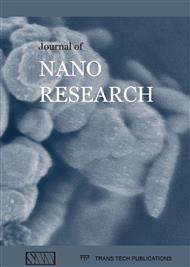[1]
T. Yang, C. Shen, H. Yang, C. Xiao, Z. Xu, S. Chen, D. Shi, H. Gao, Synthesis, characterization and self assemblies of magnetite nanoparticles, Surf. and Interface Anal. 38(2006) 1063-1067.
DOI: 10.1002/sia.2329
Google Scholar
[2]
H. El Ghandoor, H. Zidan, Mostafa M. H. Khalil, M. I. M. Ismail, Synthesis and some physical properties of magnetite (Fe3O4) nanoparticles, Int. J. Electrochem. Sci. 7(2012) 5734-5745.
DOI: 10.1016/s1452-3981(23)19655-6
Google Scholar
[3]
A. Akbarzadeh, M. Samiei, S. Davaran, Magnetic nanoparticles: preparation, physical properties, and applications in biomedicines, Nanoscale Research Letters. 7 (2012) 144.
DOI: 10.1186/1556-276x-7-144
Google Scholar
[4]
A. Durdureanu - Angheluta, M. Pinteala, B. C. Simionescu, Tailored and functionalized magnetic particles for biomedical and industrial applications, Material Science and Technology, In Tech, Rijeka (Croatia), (2012).
DOI: 10.5772/30217
Google Scholar
[5]
S. Singamaneni, V. N. Bliznyuk, C. Binek, E. Y. Tsymbal, Magnetic nanoparticles: recent advances in synthesis, self-assembly and applications, J. Mater. Chem. 21(2011) 16819–16845.
DOI: 10.1039/c1jm11845e
Google Scholar
[6]
L. Blaney, Magnetite (Fe3O4): Properties, synthesis and applications, The Lehigh review, 15(2007) 33-81.
Google Scholar
[7]
Y. Wei, B. Han, X. Hu, Y. Lin, X. Wang, X. Deng, Synthesis of Fe3O4 nanoparticles and their magnetic properties, Procedia Engineering. 27 (2012) 632-637.
DOI: 10.1016/j.proeng.2011.12.498
Google Scholar
[8]
A. G. Roca, M. P. Morales, K. O'Grady, C. J. Serna, Structural and magnetic properties of uniform magnetite nanoparticles prepared by high temperature decomposition of organic precursors, Nanotechnology. 17 (2006) 2783–2788.
DOI: 10.1088/0957-4484/17/11/010
Google Scholar
[9]
S. Singamaneni, V. N. Bliznyuk, C. Binek, E. Y. Tsymbal, Magnetic nanoparticles: recent advances in synthesis, self-assembly and applications, J. Mater. Chem. 21(2011) 16819–16845.
DOI: 10.1039/c1jm11845e
Google Scholar
[10]
K. Gupta, M. Gupta, Synthesis and surface engineering of iron oxide nanoparticles for biomedical applications, Biomaterials. 26 (2005) 3995–4021.
DOI: 10.1016/j.biomaterials.2004.10.012
Google Scholar
[11]
J. B. Mamania, L. F. Gamarraa, G. E. Souza Britod, Synthesis and characterization of Fe3O4 nanoparticles with perspectives in biomedical applications, Materials Research. 17(3) (2014) 542-549.
Google Scholar
[12]
P. Tartaj, M. P. Morales, S. V. Verdaguer, T. G. Carreno and C. J. Serna, The preparation of magnetic nanoparticles for applications in biomedicine, Journal of Physics D: Applied Physics. 36, (2003) R182–R197.
DOI: 10.1088/0022-3727/36/13/202
Google Scholar
[13]
J. Motoyama, T. Hakata, R. Kato, N. Yamashita, T Morino, T. Kobayashi ,H. Honda, Size dependent heat generation of magnetite nanoparticles under AC magnetic field for cancer therapy, BioMagnetic Research and Technology, 6: 4 (2008) 1-9.
DOI: 10.1186/1477-044x-6-4
Google Scholar
[14]
S. Sun, H. Zeng, Size-controlled synthesis of magnetite nanoparticles, J. Am. Chem. Soc. 124 (2002) 8204-8205.
DOI: 10.1021/ja026501x
Google Scholar
[15]
T. J. Daou, G. Pourroy, S. B. Colin, J. M. Greneche, C. U. Bouillet, P. Legare, P. Bernhardt, C. Leuvrey, and G. Rogez, Hydrothermal synthesis of monodisperse magnetite nanoparticles, " Chem. Mater. 18 (2006) 4399-4404.
DOI: 10.1021/cm060805r
Google Scholar
[16]
M. C. Mascolo, Y. Pei, T. A. Ring, Room temperature co-precipitation synthesis of magnetite nanoparticles in a large pH window with different bases, Materials. 6 (2013) 5549-5567.
DOI: 10.3390/ma6125549
Google Scholar
[17]
J. Lopez, F. González, F. Bonilla, G. Zambrano, M. Gómez, Synthesis and characterization of Fe3O4 magnetic nanofluid, Rev. Latin Am. Metal. Mat. 30 (1) (2010) 60-66.
Google Scholar
[18]
M. Das, P. Dhak, S. Gupta, D. Mishra, T. Maiti, A. Basak, P. Pramanik, Highly biocompatible and water dispersible amine functionalized magnetite nanoparticles, prepared by a low temperature, air assisted polyol process: A new platform for bio-separation and diagnostics, Nanotechnology. 21(2010).
DOI: 10.1088/0957-4484/21/12/125103
Google Scholar
[19]
P. A. Sundaram, R. Augustine, M. Kannan, Extracellular biosynthesis of iron oxide nanoparticles by Bacillus subtilis strains isolated from Rhizosphere soil, Biotechnology and Bioprocess Engineering. 17 (2012) 835-840.
DOI: 10.1007/s12257-011-0582-9
Google Scholar
[20]
A. Angermann, J. Topfer, Synthesis of magnetite nanoparticles by thermal decomposition of ferrous oxalate dehydrate, J. Mater. Sci. 43 (2008) 5123–5130.
DOI: 10.1007/s10853-008-2738-3
Google Scholar
[21]
F. Zhao, B. Zhang, L. Feng, Preparation and magnetic properties of magnetite nanoparticles, Materials Letters. 68 (2012) 112–114.
DOI: 10.1016/j.matlet.2011.09.116
Google Scholar
[22]
S. Rongrong, G. Guanhua, Y. Ran, Z. Kechao, Q. Guanzhou, L. Xiaohe, Controlled synthesis and characterization of monodisperse Fe3O4 nanoparticles, Chinese Journal of Chemistry. 27 (2009) 739-744.
Google Scholar
[23]
L. Wang, J. S. Jiang, Preparation of Fe3O4 spherical nanoporous particles.
Google Scholar
[24]
facilitated by polyethylene glycol 4000, Nanoscale Res Lett. 4 (2009) 1439–1446.
Google Scholar
[25]
G. Qiu, Q. Wang, M. Nie, Polypyrrole-Fe3O4 magnetic nanocomposite prepared by ultrasonic irradiation, Macromol. Mater. Eng. 291 (2006) 68–74.
DOI: 10.1002/mame.200500285
Google Scholar
[26]
A. Abedini, A. R. Daud, M. A. A. Hamid, N. K. Othman, Radiolytic formation of Fe3O4 nanoparticles: Influence of radiation dose on structure and magnetic properties, PLOS ONE. 9 (3) (2014) 1-8.
DOI: 10.1371/journal.pone.0090055
Google Scholar
[27]
J. Xu, H. Yang, W. Fu, K. Du, Y. Sui, J. Chen, Y. Zeng, M. Li, G. Zou, Preparation and magnetic properties of magnetite nanoparticles by sol–gel method, Journal of Magnetism and Magnetic Materials. 309 (2007) 307–311.
DOI: 10.1016/j.jmmm.2006.07.037
Google Scholar
[28]
Lemine, K. Omri, B. Zhang, L. El Mirb, M. Sajieddine, A. Alyamani, M. Bououdina, Sol–gel synthesis of 8 nm magnetite (Fe3O4) nanoparticles and their magnetic properties, Superlattices and Microstructures. 52(2012) 793–799.
DOI: 10.1016/j.spmi.2012.07.009
Google Scholar


